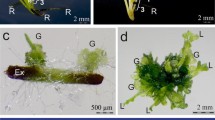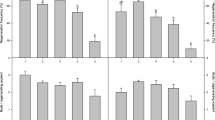Summary
A histological study ofin vitro cultured cotyledonary expiants of tomato (Lycopersicon esculentum) was performed in order to determine the site (differentiated tissue or developing callus) and the mode of plant regeneration.
Results have shown that callus develops at the excision sites of cotyledonary expiants and that shoots are formed exclusively within the unorganized callus: excision areas are the only morphogenetic sites and the proximal excision is the preferred site for plant regeneration.
Shoots differentiate by organogenesis within the superficial region of the callus. Few neocambial cells cooperate in the neoformation. Origin from a single cell is highly unlikely since rarely observed single activated cells never developed into shoots.
Regenerated plants may be chimeras if invitro culture induces genetic diversity in the initial cells.
Similar content being viewed by others
Abbreviations
- IAA:
-
Indole-3-acetic acid
- c:
-
callus
- d:
-
vegetative dome
- s:
-
shoot
- ad:
-
adaxial
- ab:
-
abaxial
- t:
-
tracheid
- p:
-
parenchyma
- S:
-
sieve tube
References
Altamura MM, Monacelli B, Pasqua G, Mazzolani G (1984) Organogenetic capacities of thin cellular layers culturedin vitro. Ann Bot (Roma) 42: 45–55
Avery GS JR (1933) Structure and germination of tobacco seed and the developmental anatomy of the seedling plant. Am J Bot 20: 309–327
Buiatti M, Marcheschi G, Tognoni F, Collina Grenci F, Martini G (1985) Genetic variability induced by tissue culture in tomato (Lycopersicon esculentum). J Plant Breed 94: 162–165
Coleman WK, Greyson RI (1976) The growth and development of the leaf in tomato (Lycopersicon esculentum). II. Leaf Ontogeny. Can J Bot 54: 2704–2717
— — (1977) Analysis of root formation in leaf discs ofLycopersion esculentum Mill. culturedin vitro. Ann Bot 41: 307–320
d'Amato (1985) Cytogenetics of plant cell and tissue cultures and their regenerates. CRC Crit Rev Plant Sci 3: 73–112
Evans DA, Sharp WR (1983) Single gene mutations in tomato plants regenerated from tissue culture. Science 221: 949–951
— — (1986) Applications of somaclonal variation. Biotechnology 4: 528–532
Fox JT (1986) Embracing somaclonal variation for agricultural biotechnology. ASM News 52: 196–199
Gavazzi G, Tonelli C, Todesco G, Arreghini E, Raffaldi E, Vecchio F, Barbuzzi G., Biasini MG, Sala F (1987) Somaclonal variationversus chemically induced mutagenesis in tomato (Lycopersicon esculentum). Theor Appl Genet 74: 733–738
Larkin PJ, Scowcroft WR (1981) Somaclonal variation. A novel source of variability from cell cultures for plant improvement. Theor Appl Genet 60: 197–214
Mazzi V (1977) Manuale di tecniche istologiche ed istochimiche. Piccin Ed, Padova, p 127
Murashige T, Skoog F (1962) A revised medium for rapid growth and bio-assay with tobacco tissue cultures. Physiol Plant 15: 473–497
Sala F, Biasini MG (1986) Heritable variability induced by thein vitro culture and genetic improvement of cultivated plants. Giorn Bot Ital 120: 43–54
Author information
Authors and Affiliations
Rights and permissions
About this article
Cite this article
Monacelli, B., Altamura, M.M., Pasqua, G. et al. The histogenesis of somaclones from tomato (Lycopersicon esculentum Mill.) cotyledons. Protoplasma 142, 156–163 (1988). https://doi.org/10.1007/BF01290872
Received:
Accepted:
Issue Date:
DOI: https://doi.org/10.1007/BF01290872




